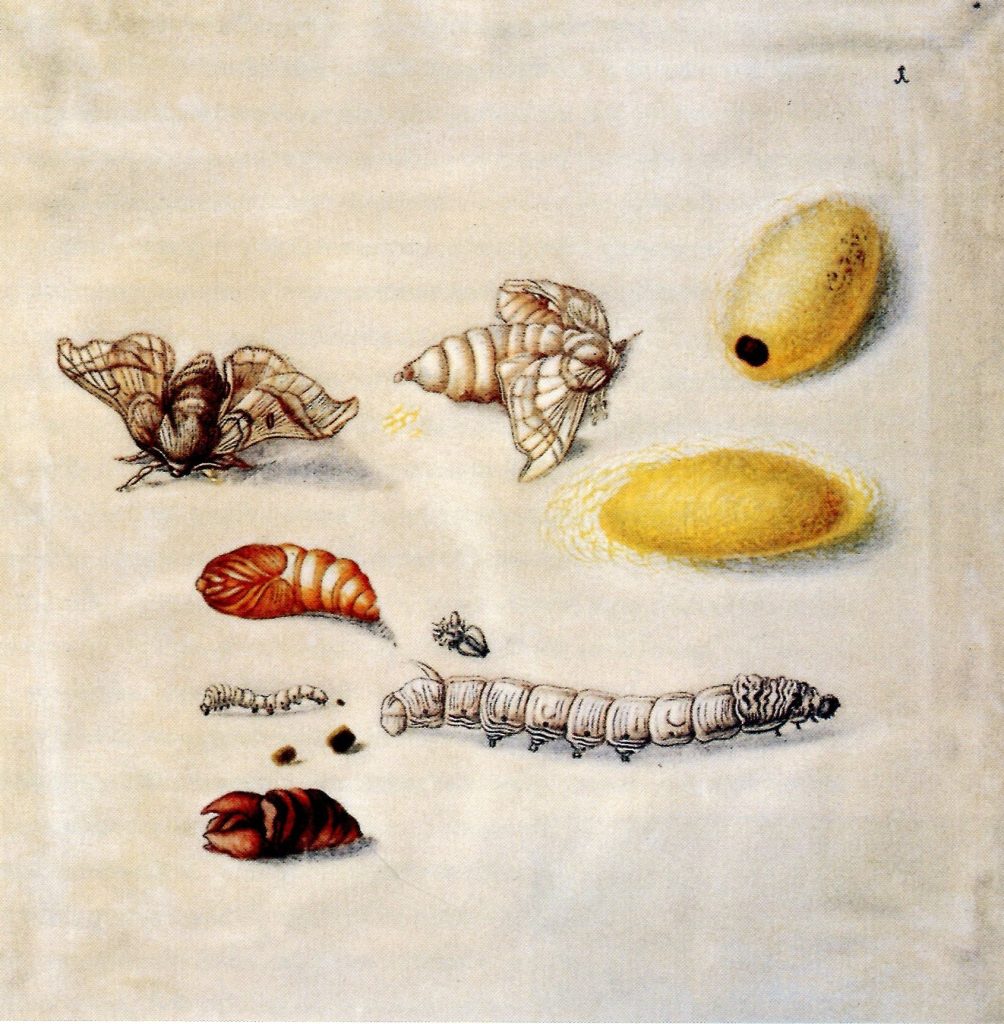
Maria Sibylla Merian (1647-04-02 – 1717-01-13) was born in Frankfurt am Main, she is notable as an entomologist and scientific illustrator. She spent much of her life living in what is now Germany and the Netherlands, where she died, but also two years in the Dutch colony of Surinam, in South America. Today, it is 375 years since she was born.
After her father, Matthäus Merian der Ältere (1593 – 1650), a Swiss-born engraver/ publisher, died when she was three, her widowed mother, Johanna Sybilla Heim(ius), remarried Jabob Marrel (1613/4 – 1681), a still-life painter, in 1651. Merian received her artistic training from Marrel.
Many Dutch dissenters also moved to Frankfurt, seeking refuge from persecution in the Netherlands. They turned their attention to silkworm breeding and the silk trade towards the end of the 16th century. Maria Sibylla Merian’s earliest nature studies had their origins in this context. She started to collect insects as an adolescent. At 13, she raised silkworms.
In 1665, Merian married Johann Andreas Graff, an apprentice of Marrel. In 1668, her first child, Johanna, was born. The family moved to Nuremberg in 1670. In addition to painting and other artistic activities she gave drawing lessons to unmarried daughters of wealthy families, which helped her family financially, and gave her with access to private gardens, where she could collect and document insects.
She published her first book of natural illustrations in 1675. In 1678 a second daughter, Dorothea Maria, was born, and the family moved back to Frankfurt am Main. In 1679 she published the first volume of a two-volume series on caterpillars, opening with a presentation of the silkworm’s life-cycle.
Merian’s marriage was unhappy, and she moved in with her mother after her stepfather died in 1681. The second volume on caterpillars appearing in 1683. Each volume contained 50 plates that she engraved and etched. These documented the process of insect metamorphosis, and recorded the plant hosts of 186 European insect species. She also included descriptions of insect life cycles.
In 1683, Merian travelled to Gottorp, in Schleswig-Holstein, where she became attracted to the Labadist community, founded by Jean de Labadie (1610–1674). He originally came from the Bordeaux region of France. Later, the community moved to Walta Castle, at Wieuwerd in Friesland.
In 1685, Merian moved with her mother, husband, and children to Friesland. The Labadist community generated income from farming, milling and craftsmenship. Children were tutored communally. Women had traditional roles. A printing press was set up, to disseminate writings by Labadie and others, including Anna van Schurman, (1607 – 1678) painter/ engraver/ poet/ scholar and defender of female education. Another member, Hendrik van Deventer (1651 – 1724),[skilled in chemistry and medicine, set up a laboratory and was regarded as a pioneering obstetrician.
Here, Merian studied natural history and Latin, used as a scientific language. On Friesland’s moors she observed frog development, collecting and dissecting them. Merian’s mother died in 1690, and Merian moved, with her daughters, to Amsterdam in 1691. In 1692, her husband divorced her, and her daughter Johanna married Jakob Hendrik Herolt, a successful merchant in the Surinam trade.
In 1699, Merian and her younger daughter, Dorothea Maria Graff (1678–1743), travelled to Surinam to study and record the tropical insects native to the region. This was financed by selling 255 paintings. For two years she travelling throughout the colony, sketching local animals and plants, recording local/ native names and describing local uses.
Merian criticised the colonial merchants for their obsession with sugar. She took a broader interest in local agriculture, especially the vegetables and fruits that could be grown in Suriname, such as the pineapple. She also condemned their treatment of slaves. One such enslaved person assisted her in her research, and allowed her to interact with other Amerindian and African slaves.
In 1705, she published Metamorphosis insectorum Surinamensium. Merian’s Metamorphosis has been credited with influencing a range of naturalist illustrators. In Metamorphosis, she writes: “I have been concerned with the study of insects since my youth. I started with silkworms in my native Frankfurt. Later I realized that other caterpillars developed into much more beautiful diurnal and nocturnal butterflies.”
Because of her documented observations of butterfly metamorphosis, she is often considered to be the founder, and a significant contributor, to the field of entomology. Through her studies, Merian discovered many facts about insect life, earning her the title of mother of biology.

More information about the life and work of Merian can be found in an article by Tanya Latty.

